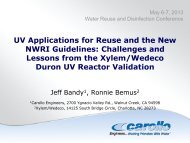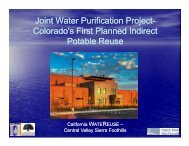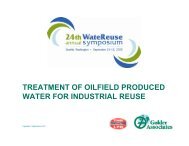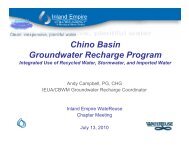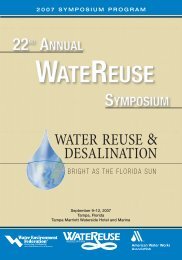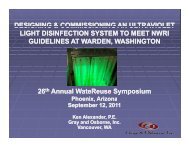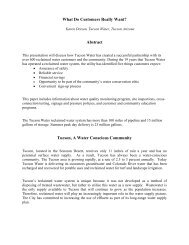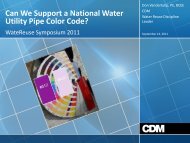Desalination Plant Intakes - WateReuse Association
Desalination Plant Intakes - WateReuse Association
Desalination Plant Intakes - WateReuse Association
Create successful ePaper yourself
Turn your PDF publications into a flip-book with our unique Google optimized e-Paper software.
WATEREUSE ASSOCIATIONDESALINATION COMMITTEE<strong>Desalination</strong> <strong>Plant</strong> <strong>Intakes</strong> –Impingement and Entrainment Impacts and SolutionsWhite PaperINTRODUCTIONSeawater intakes are an integral part of every seawater desalination plant. The purpose of thiswhite paper is to provide an overview of potential impingement and entrainment (I&E) impactsassociated with the operation of open ocean intakes for seawater desalination plants and todiscuss alternative solutions for efficient and cost effective I&E reduction. For information onalternative intakes for seawater desalination plants, refer to the <strong>WateReuse</strong> <strong>Association</strong>’s whitepaper titled “Overview of <strong>Desalination</strong> <strong>Plant</strong> Intake Alternatives.”WHAT IS IMPINGEMENT AND ENTRAINMENT?As with any other natural surface water source currently used for fresh water supply around theglobe, seawater contains aquatic organisms (algae, plankton, fish, bacteria, etc.). Impingementoccurs when organisms sufficiently large to avoid going through the screens are trapped againstthem by the force of the flowing source water – i.e., algae, plankton and bacteria are not exposedto impingement. On the other hand entrainment occurs when marine organisms enter thedesalination plant intake, are drawn into the intake system, and pass through to the treatmentfacilities.Impingement typically involves adult aquatic organisms (fish, crabs, etc.) that are large enoughto actually be retained by the intake screens, while entrainment mainly affects aquatic speciessmall enough to pass through the particular size and shape of intake screen mesh. Impingementand entrainment of aquatic organisms are not unique to open intakes of seawater desalinationplants only. Conventional open freshwater intakes from surface water sources (i.e., rivers, lakes,estuaries) may also cause measurable impingement and entrainment.A third term, “entrapment,” is then used when describing impacts associated with offshore intakestructures connected to an on-shore intake screen and pump station via long conveyance pipelineor tunnel. Organisms that enter the offshore intake and cannot swim back out of it are oftenreferred to as entrapped 1 . Such marine organisms could either be impinged on the intake screensor entrained if they pass through the screens and enter the downstream facilities of thedesalination plant.1 http://www.waterlink-international.com/download/whitepaper_uploadfile_21.pdfSeawater <strong>Desalination</strong> <strong>Plant</strong> <strong>Intakes</strong> – Impingement and Entrainment Page 1




